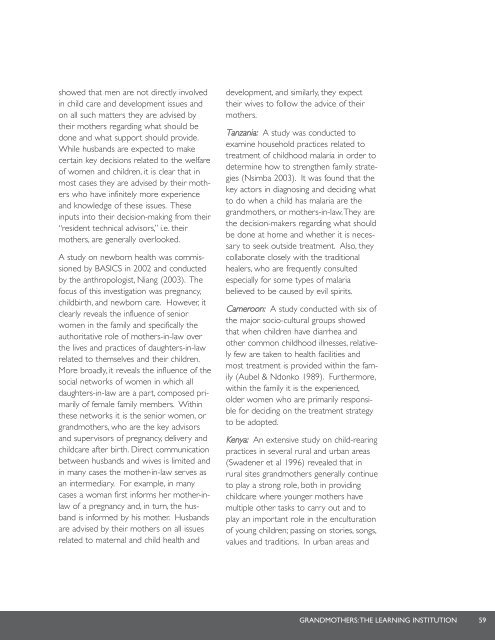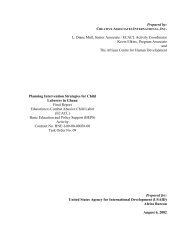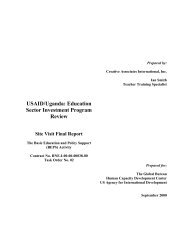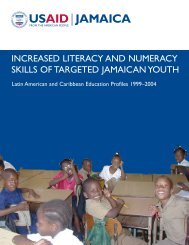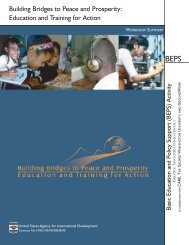gr<strong>and</strong>mothers have a great influence onthe knowledge <strong>and</strong> practices of youngerwomen <strong>and</strong> their children. They arerespected because of their experience caringfor children, their advice is frequentlysought, <strong>and</strong> they often are directly involvedin caring for young children” (Aubel &Hoemeke 1995, 33). It was recommendedthat future child survival strategies shoulddirectly involve gr<strong>and</strong>mothers given theimportant role they play at the householdlevel.Benin: In Bariba culture, when youngwomen marry, their husb<strong>and</strong>s expect theolder, experienced women in the family toadvise <strong>and</strong> look after their wives, especiallywhen they are pregnant <strong>and</strong> after theygive birth (Bio 2003).This is true both inrural <strong>and</strong> more urban areas. For couplesliving in more urban areas, away from thepaternal household, when a woman isabout seven months pregnant one of theolder women in the family, often an aunt,goes to stay with the couple in order toprovide the close follow-up required thelast months of the pregnancy. The “aunt,”as she is referred to, observes <strong>and</strong> providesadvice to the pregnant woman onher diet, work <strong>and</strong> other activities.Especially with the first child the husb<strong>and</strong> isnot supposed to be too involved eitherduring the pregnancy nor after his wifegives birth. The belief is that the childbelongs to, <strong>and</strong> is the responsibility of thewhole family, but especially of the femalesin the household. It is expected that all ofthe “aunties” in the family, i.e. the maturewomen, will play a role in advising <strong>and</strong> caringfor the young woman <strong>and</strong> her infant.After birth, either the “auntie” stays on tocare for the newborn <strong>and</strong> new mother orthe mother <strong>and</strong> newborn go to stay withthe mother-in-law, often for two years, tobenefit from the informal teaching <strong>and</strong>support required by a new mother. In virtuallyall cases, husb<strong>and</strong>s assume thatresponsibility for caring for their wives <strong>and</strong>young children will fall to their mothers<strong>and</strong> other aunties, based on their experience<strong>and</strong> age.Senegal: In the past ten years, four studieshave comprehensively documented the significantrole <strong>and</strong> influence of gr<strong>and</strong>motherson breastfeeding, on maternal <strong>and</strong> childnutrition, on practices with newborns, <strong>and</strong>care of young children. In l995, a studyfunded by USAID (MOH/WELLSTART),coordinated by the author of this review,showed that,“In both rural <strong>and</strong> urbanareas the predominant influence onwomen’s practices related to breastfeedingis the advice <strong>and</strong> support they receivefrom the older women who are part oftheir social networks. Compared withhealth workers, these older women arecloser to them, more respected, <strong>and</strong> havemore influence on them.” (5) From birth,women are advised on how to care fortheir child in all respects, by their mothersin-law,their own mothers, <strong>and</strong> by otherexperienced women in the family.In 2001, Christian Children’s Fund conducteda study (Aubel et al.) on the role ofgr<strong>and</strong>mothers in Maternal Child Health(MCH) in the context of its child survivalproject in western Senegal. It documentedthe central <strong>and</strong> multi-dimensional roleplayed by gr<strong>and</strong>mothers in family life <strong>and</strong>specifically related to issues concerningwomen <strong>and</strong> children. The study clearly58 UNITED STATES AGENCY FOR INTERNATIONAL DEVELOPMENT
showed that men are not directly involvedin child care <strong>and</strong> development issues <strong>and</strong>on all such matters they are advised bytheir mothers regarding what should bedone <strong>and</strong> what support should provide.While husb<strong>and</strong>s are expected to makecertain key decisions related to the welfareof women <strong>and</strong> children, it is clear that inmost cases they are advised by their motherswho have infinitely more experience<strong>and</strong> knowledge of these issues. Theseinputs into their decision-making from their“resident technical advisors,” i.e. theirmothers, are generally overlooked.A study on newborn health was commissionedby BASICS in 2002 <strong>and</strong> conductedby the anthropologist, Niang (2003). Thefocus of this investigation was pregnancy,childbirth, <strong>and</strong> newborn care. However, itclearly reveals the influence of seniorwomen in the family <strong>and</strong> specifically theauthoritative role of mothers-in-law overthe lives <strong>and</strong> practices of daughters-in-lawrelated to themselves <strong>and</strong> their children.More broadly, it reveals the influence of thesocial networks of women in which alldaughters-in-law are a part, composed primarilyof female family members. Withinthese networks it is the senior women, orgr<strong>and</strong>mothers, who are the key advisors<strong>and</strong> supervisors of pregnancy, delivery <strong>and</strong>childcare after birth. Direct communicationbetween husb<strong>and</strong>s <strong>and</strong> wives is limited <strong>and</strong>in many cases the mother-in-law serves asan intermediary. For example, in manycases a woman first informs her mother-inlawof a pregnancy <strong>and</strong>, in turn, the husb<strong>and</strong>is informed by his mother. Husb<strong>and</strong>sare advised by their mothers on all issuesrelated to maternal <strong>and</strong> child health <strong>and</strong>development, <strong>and</strong> similarly, they expecttheir wives to follow the advice of theirmothers.Tanzania: A study was conducted toexamine household practices related totreatment of childhood malaria in order todetermine how to strengthen family strategies(Nsimba 2003). It was found that thekey actors in diagnosing <strong>and</strong> deciding whatto do when a child has malaria are thegr<strong>and</strong>mothers, or mothers-in-law.They arethe decision-makers regarding what shouldbe done at home <strong>and</strong> whether it is necessaryto seek outside treatment. Also, theycollaborate closely with the traditionalhealers, who are frequently consultedespecially for some types of malariabelieved to be caused by evil spirits.Cameroon: A study conducted with six ofthe major socio-cultural groups showedthat when children have diarrhea <strong>and</strong>other common childhood illnesses, relativelyfew are taken to health facilities <strong>and</strong>most treatment is provided within the family(Aubel & Ndonko 1989). Furthermore,within the family it is the experienced,older women who are primarily responsiblefor deciding on the treatment strategyto be adopted.Kenya: An extensive study on child-rearingpractices in several rural <strong>and</strong> urban areas(Swadener et al 1996) revealed that inrural sites gr<strong>and</strong>mothers generally continueto play a strong role, both in providingchildcare where younger mothers havemultiple other tasks to carry out <strong>and</strong> toplay an important role in the enculturationof young children; passing on stories, songs,values <strong>and</strong> traditions. In urban areas <strong>and</strong>GRANDMOTHERS:THE LEARNING INSTITUTION59
- Page 1 and 2:
GRANDMOTHERS:A LEARNING INSTITUTION
- Page 3:
GRANDMOTHERS:A LEARNING INSTITUTION
- Page 11 and 12:
EXECUTIVE SUMMARYSociety itself fai
- Page 13 and 14:
Education, the Bernard Van LeerFoun
- Page 15 and 16:
SEVERAL FACTORS CONTRIBUTE TO THELI
- Page 17:
- Who am I? Assign children to askf
- Page 20 and 21:
in educational activities on home t
- Page 22 and 23:
“A grandmother’s understandingo
- Page 24 and 25:
“Culture tells peoplehow to view
- Page 26 and 27: attention given to grandmothers’
- Page 28 and 29: social work, including family syste
- Page 30 and 31: mation from Azerbaijan (McNulty 200
- Page 32 and 33: “The status of eldersin tradition
- Page 34 and 35: “As women, thegrandmothers haveli
- Page 36 and 37: members often consult the moreexper
- Page 38 and 39: “Social capital is a community’
- Page 40 and 41: In a collaborative effort between
- Page 42 and 43: in-laws and the additional free tim
- Page 44 and 45: "Involving grandmothersin community
- Page 50 and 51: CULTURALLY-ADAPTED EDUCATIONMATERIA
- Page 52 and 53: strated the power of participatory
- Page 54 and 55: effects of the new ideas, their con
- Page 57 and 58: V. GRANDMOTHERS: A LEARNING INSTITU
- Page 59 and 60: Many health and development workers
- Page 61 and 62: VI. RECOMMENDATIONS FORBASIC EDUCAT
- Page 63 and 64: parents themselves did not go to sc
- Page 65 and 66: community ties by increasing teache
- Page 67 and 68: of millions. On the other hand, som
- Page 69: teachers, teacher abuse of children
- Page 73 and 74: APPENDIX B:ANNOTATEDREFERENCES ON T
- Page 75: acceptable for younger women to mak
- Page 79 and 80: ecause they had more time to devote
- Page 81 and 82: matrilineal or patrilineal areas
- Page 83 and 84: diet, work, fetal development, sexu
- Page 85 and 86: in the family and social networks.
- Page 87 and 88: elated, for example, to early child
- Page 89 and 90: REFERENCESAdams, A. M., S. Madhavan
- Page 91 and 92: BASICS and LINKAGES. 1998. Influenc
- Page 93 and 94: Childhood Education and Development
- Page 95 and 96: Krishna, A. and N. Uphoff. June 199
- Page 97 and 98: Sear, R., R. Mace, and I. A. McGreg
- Page 99 and 100: ABOUT THE AUTHORThis review was pre


